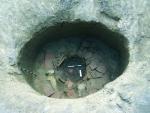Summary (English)
ARCHAEOLOGICAL EXPLORATIONS NEAR THE VILLAGE OF KOZLOVETS (Petya Andreeva – petya_letters@abv.bg) A pile of tegulae and imbrices from the collapsed roof of a building was excavated. A bronze figurine of Zeus striking with a thunderbolt was found in the building. Judging from the pottery and the coins, the building dated to the 2nd – first half of the 3rd centuries AD. A wall of another building was excavated; a votive relief of the Thracian Horseman, terracotta lamps and a small bronze bell were found there, indicating cult activities. According to the data from the geomagnetic and electric resistivity survey on the site, collapsed roofs from other buildings were discovered as well. The finds in the building included sherds, including from amphorae, coins, the earliest one of Nero, a silver ring with an intaglio showing an eagle, a fragment from a brick with a stamp that read: C ATON MА – C(ai) Anton(i) ma(gistri), found together with coins of Caracalla and Maximinus Thrax. Gaius Antonius was probably the owner of a private brickyard in Dimum or Novae. The monumental roofs of the buildings indicated walls constructed over solid foundations. Pits were discovered between the buildings, containing sherds, fragmentary building ceramics, animal bones and skeletons. A ritual pit was discovered as well, containing a pitcher surrounded with tegulae. The analysis of the osteological material showed the presence of dogs (59.05%), oxen (19.56%), horses (12.16%), pigs (3.55%), sheep/goats (5.68%) and freshwater mussels (Unio pictorum). The settlement was located in the hinterland of Novae and existed from the end of the 1st to mid 3rd centuries AD. The earliest denarius that was found belonged to Nero and the latest one to Severus Alexander. The Roman colonial bronze coins of Nicopolis ad Istrum prevailed.
- Petya Andreeva - Archaeological Institute with Museum
Director
- Petya Andreeva - Archaeological Institute with Museum
Team
Research Body
- Archaeological Institute with Museum






![Download [PDF]](/excavation/skins/fasti/images/results/download_sml.png)

